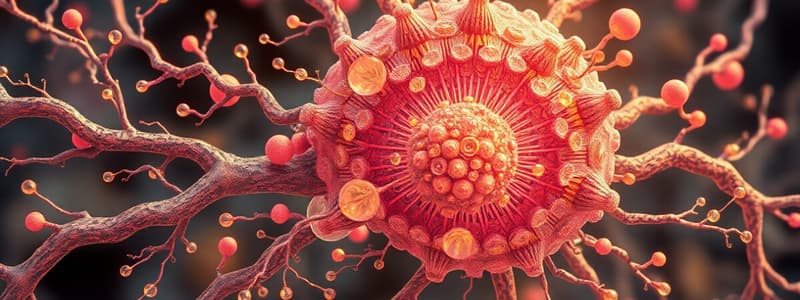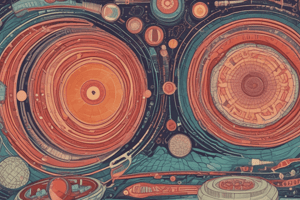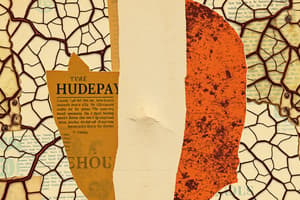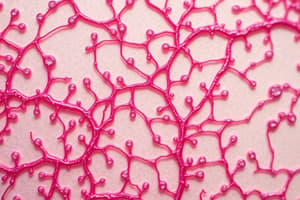Podcast
Questions and Answers
What is a primary role of macrophages in the immune system?
What is a primary role of macrophages in the immune system?
- Phagocytic activity (correct)
- Hormone production
- Allergic response initiation
- Formation of antibodies
Which characteristic feature can macrophages exhibit under pathological conditions?
Which characteristic feature can macrophages exhibit under pathological conditions?
- Reduction in size
- Absence of lysosomes
- Enhancement of melanin production
- Formation of epithelioid cells (correct)
Which cell type is NOT a name associated with macrophages in various organs?
Which cell type is NOT a name associated with macrophages in various organs?
- Langerhans cells
- Osteoclasts
- Fibroblasts (correct)
- Dust cells
What structure indicates that reticular cells are multipotent stem cells?
What structure indicates that reticular cells are multipotent stem cells?
Which staining method is specifically used to identify reticular fibers associated with reticular cells?
Which staining method is specifically used to identify reticular fibers associated with reticular cells?
What is the primary cell type involved in the repair of connective tissue?
What is the primary cell type involved in the repair of connective tissue?
What occurs during wound contraction in tissue repair?
What occurs during wound contraction in tissue repair?
How do unilocular adipocytes appear under light microscopy?
How do unilocular adipocytes appear under light microscopy?
Which function is primarily associated with multilocular adipocytes?
Which function is primarily associated with multilocular adipocytes?
What is a characteristic feature of macrophages in connective tissue?
What is a characteristic feature of macrophages in connective tissue?
Where are unilocular adipocytes primarily found?
Where are unilocular adipocytes primarily found?
Which statement about fat cells is true regarding multilocular adipocytes?
Which statement about fat cells is true regarding multilocular adipocytes?
The appearance of macrophages under light microscopy can be described as:
The appearance of macrophages under light microscopy can be described as:
What is the primary origin of connective tissue?
What is the primary origin of connective tissue?
Which of the following fibers is NOT a component of connective tissue?
Which of the following fibers is NOT a component of connective tissue?
In what form does the extracellular matrix exist in blood?
In what form does the extracellular matrix exist in blood?
Which function does connective tissue NOT primarily serve?
Which function does connective tissue NOT primarily serve?
Which statement best describes the cellular composition of connective tissue?
Which statement best describes the cellular composition of connective tissue?
Which type of connective tissue fiber is primarily involved in providing elasticity?
Which type of connective tissue fiber is primarily involved in providing elasticity?
What is the primary function of undifferentiated mesenchymal cells (UMCs)?
What is the primary function of undifferentiated mesenchymal cells (UMCs)?
Which of the following statements is true regarding the ground substance of connective tissue?
Which of the following statements is true regarding the ground substance of connective tissue?
What role does connective tissue play in relation to injuries?
What role does connective tissue play in relation to injuries?
Which type of cell is primarily responsible for healing and repair of connective tissue?
Which type of cell is primarily responsible for healing and repair of connective tissue?
What characteristic distinguishes stable and long-lived fixed cells from transient and migrating wandering free cells?
What characteristic distinguishes stable and long-lived fixed cells from transient and migrating wandering free cells?
Which cell type leaves the bloodstream to provide immunity in connective tissue?
Which cell type leaves the bloodstream to provide immunity in connective tissue?
What is a key structural feature of fibroblasts when observed under light microscopy?
What is a key structural feature of fibroblasts when observed under light microscopy?
Which type of connective tissue cell plays a role in lipid storage?
Which type of connective tissue cell plays a role in lipid storage?
What distinguishes myofibroblasts from typical fibroblasts?
What distinguishes myofibroblasts from typical fibroblasts?
Which cell type is not considered a wandering free cell in connective tissue?
Which cell type is not considered a wandering free cell in connective tissue?
Flashcards are hidden until you start studying
Study Notes
Connective Tissue
- Mesenchymal origin
- Composed of:
- Cells
- Fibers (collagen, elastic, reticular)
- Ground substance (extracellular matrix)
- Cells are widely separated due to large amounts of extracellular matrix
- Varies in firmness:
- Cartilage: Firm
- Bone: Hard
- Blood: Fluid
- Some types are penetrated by:
- Blood vessels
- Lymphatics
- Nerves
Connective Tissue Functions
- Support and connect cells, tissues, and organs
- Cells facilitate healing of injured tissues
- Provide resistance to stress in:
- Cartilage
- Bone
- Tendons
- Ligaments
- Capsules of organs
- Act as a medium for exchange in:
- Blood
- Lymph
- Connective tissue proper
- Contribute to immunity through:
- Plasma
- Mast cells
- White blood cells
- Adipose cells and adipose tissue facilitate lipid storage and metabolism
Connective Tissue Cells
- Fixed cells:
- Fibroblasts:
- Origin: Undifferentiated mesenchymal cells (UMCs) and pericytes
- Location: All types of connective tissue
- Function:
- Formation of connective tissue fibers
- Formation of ground substance
- Involved in healing and repair of wounds
- Fibrocytes:
- Smaller and spindle-shaped compared to fibroblasts
- Fewer processes
- Elongated, dark nucleus
- Myofibroblasts:
- Share characteristics of fibroblasts and smooth muscle cells
- Contain actin and myosin
- Involved in wound closure
- Fat Cells (Adipocytes)
- Unilocular (White Fat)
- Location: White adipose tissue
- Appearance: Rounded or oval, large cells with peripheral, flattened nucleus
- Unilocular (White Fat)
- Fibroblasts:
- Cytoplasm appears pale and reduced to a thin rim around a large fat droplet
- In H&E staining, fat dissolves, so cells appear as large vacuoles (signet-ring appearance)
- Stains orange with Sudan III - Function: Storage of fat, support organs, and heat insulation - Multilocular (Brown Fat) - Location: Brown adipose connective tissue - Appearance: Small rounded cell with round nucleus and many small fat droplets
- Contains many mitochondria, giving it a brown appearance
- Function: Heat generation
- Macrophages:
- Origin: Blood monocytes
- Location: Scattered in connective tissue or fixed to collagen fibers
- Appearance: Large, branched cell with irregular cell boundary (pseudopodia) and dark, kidney-shaped nucleus
- Macrophages:
- Cytoplasm is pale basophilic and vacuolated
- Function:
- Phagocytic - engulf and destroy foreign particles and cellular debris
- Antigen-presenting cells (APCs): present antigens to immune cells
- Reticular Cells:
- Origin: Undifferentiated mesenchymal cells (UMCs)
- Location: Reticular stroma of parenchymatous organs (commonest cell in reticular CT)
- Appearance: Small, branched cell with many processes to which reticular fibers are attached
- Reticular Cells:
- Pale basophilic with H&E staining
- Brown with silver staining
- Central, oval, pale nucleus
- Function:
- Multipotent stem cell
- Supportive function
- Antigen-presenting cells (APCs) & phagocytic function
- Undifferentiated Mesenchymal Cells (UMCs)
- Location: Connective tissue
- Appearance: Small, irregular, branched, star-shaped with pale basophilic cytoplasm
- Undifferentiated Mesenchymal Cells (UMCs)
- Large oval nucleus with visible nucleoli - Function: - Multipotent stem cells - can differentiate into other types of connective tissue cells - In bone marrow, they are responsible for the production of blood cells
- Wandering Free Cells:
- Transient and migrating cells from blood to connective tissue
- Plasma Cells:
- Origin: B lymphocytes
- Location: Connective tissue
- Function: Secrete antibodies
- Mast Cells:
- Location: Connective tissue
- Function: Contain histamine and heparin, which are involved in allergic reactions and inflammation
- Leukocytes (White Blood Cells)
- Location: Circulating in the blood and can migrate to connective tissue in response to inflammation, infection, or injury
- Function: Part of the immune system, protecting the body against infection and disease
Mononuclear Phagocytic System
- Macrophages in different organs have the same structure and function, but are called different names:
- Von Kupffer cells in the liver
- Dust cells in the lungs
- Langerhans cells in the skin
- Monocytes in the blood
- Microglia in the brain
- Osteoclasts in bone
Medical applications
- Regenerative capacity of connective tissue: Spaces left after injury to tissues whose cells do not divide (e.g., cardiac muscle) are filled by connective tissue, forming a scar
- Surgical incisions: Healing depends on the reparative capacity of connective tissue. The fibroblast is the main cell type involved.
- Wound contraction: Myofibroblasts are responsible for wound closure.
Studying That Suits You
Use AI to generate personalized quizzes and flashcards to suit your learning preferences.




